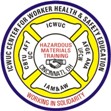 |
|||||
International Chemical Workers Union
|
|||||
| Frank Cyphers
Tel (330) 926-1444 |
International Chemical Workers Union Council |
Program Contact
| John S. Morawetz
Tel (513) 621-8882 |
ICWU Center for Worker Health & Safety Education |
Target Training Populations
 The Consortium targets chemical emergency responders and hazardous waste treatment,
storage, and disposal facility workers. This includes industrial, first receiver, Spanish
speaking and government workers and minority community members.
The Consortium targets chemical emergency responders and hazardous waste treatment,
storage, and disposal facility workers. This includes industrial, first receiver, Spanish
speaking and government workers and minority community members.
Program Description
The International Chemical Workers Union Council (ICWUC) in cooperation with a multi-union Consortium provides training under the Hazardous Waste Worker Training Program (HWWTP), the Hazmat Disaster Preparedness Training Program (HDPTP) and the Department of Energy (DOE) Training Program. The long-term organizational goal of the ICWUC Consortium is to institutionalize its model program within the member unions, Councils, and through their companies' support. The immediate educational goal is to continue delivering chemical emergency response training (Occupational Safety and Health Administration 1910.120, paragraph q) to thousands of workers with collateral duty who respond to a variety of emergencies and thousands of DOE workers who are daily exposed to a wide variety of hazardous substances. The long-term educational goal of the consortium is to provide students with the confidence, tools and problem solving skills to identify inadequacies in their facilities' hazardous materials programs and chemical emergency response programs. The long-term objective of the Consortium is to prevent work-related harm by training workers on how to best protect themselves, their communities and the environment. A strong and experienced train the trainer component is integral to all Center programs with almost all educational staff being former worker trainers.
The HWWTP provides environmental health and safety training to workers from a variety of backgrounds - first responders, first receivers and workers who handle hazardous substances. Site-specific instruction is customized to employer needs. The training accommodates workers with limited English proficiency and is rooted in various adult education techniques. Center staff are authorized to conduct a variety of OSHA classes.
In a joint multi grantee project with the UAW, we are adapting/translating Spanish language training materials, developing Spanish-speaking peer trainers and will jointly conduct hazard awareness programs. We are developing curriculum in a joint project with AFSCME to conduct worker protection training in mold prevention and clean-up programs for school staff. We have a program in EPA's ALOHA and MARPLOT software to model unintentional chemical releases and will conduct worker community programs on Occupational Shelter in Place.
The DOE program trains workers who are, or have the potential to be, employed on demolition, decommission, and decontamination projects at the DOE nuclear weapons facilities. The DOE ICWUC consortium provides 8-hour refresher, 24 hour and 40 hour training primarily at three nuclear facilities: Hanford, WA; Oak Ridge, TN; and Kansas City, MO. Workers at these sites are exposed to a variety of hazards, including radiation, heavy metals, solvents, acid gases, through their normal work, as well as due to releases and other incidents in these aging plants. DOE trainers develop all curriculums, evaluate all programs and are trained to utilize EPA software to model chemical releases.
The HDPTP project is primarily focused on training hospital based first receivers to protect themselves from exposure from victims of mass casualty chemical events. In addition trainers are trained to utilize EPA software to model intentional chemical releases and conduct worker community programs on Occupational Shelter in Place.
Project Duration
- September 1, 2005 - July 31, 2010 (HWWTP, HDPTP)
- September 1, 2005 - August 31, 2010 (DOE)
Grant Numbers
- ES06162 (HWWTP, HDPTP)
- ES09758 (DOE)
Other Participating Organizations
- American Federation of Government Employees (http://www.afge.org/Index.cfm)

- American Federation of Teachers (http://www.aft.org/)

- American Nurses Association (http://www.nursingworld.org/)

- Coalition of Black Trade Unionists (http://www.cbtu.org/)

- International Association of Machinists and Aerospace Workers (http://www.goiam.org/)

- International Chemical Workers Union (http://www.icwuc.org/)

- United Food and Commercial Workers International Union (http://www.ufcw.org/)

- University of Cincinnati (http://www.uc.edu/)


